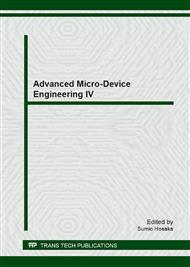p.176
p.181
p.187
p.195
p.199
p.204
p.213
p.219
p.224
Effect of Deglycosylation on the Fibrin Polymerization Depending on NaCl Concentration
Abstract:
Cleavage of carbohydrate chains linked to fibrinogen molecule results in an acceleration of fibrin polymerization, fibrin gel formation, by promoting the lateral aggregation of protofibrils. Sialic acid at the unreduced terminus of carbohydrate chain plays an essentially important role in the lateral aggre-gation. Fibrin polymerization is significantly affected by the solvent condition, e.g., pH and ionic strength. Terminal sialic acid are supposed to interact with amino terminal region of Bβ chain, in which there are many basic amino acid residues, and thus such interactions are expected to be electrostatic. In order to clarify whether the electrostatic interactions are essential for lateral aggregation, we examined temporal growth of fibrin polymerization of deglycosylated fibrinogen at high NaCl concentration. Marked acceleration of lateral aggregation was observed in deglycosylated fibrinogen even at high NaCl concentration where lateral aggregation was significantly inhibited in intact fibrinogen. These results suggest specific interactions of terminal sialic acid of the carbohydrate chain with the central E region of fibrinogen molecule, which may be important for the regulation of lateral aggregation rather than electrostatic interactions between the terminal sialic acids and the amino terminal region of Bβ chain.
Info:
Periodical:
Pages:
213-218
Citation:
Online since:
December 2013
Authors:
Price:
Сopyright:
© 2014 Trans Tech Publications Ltd. All Rights Reserved
Share:
Citation:


